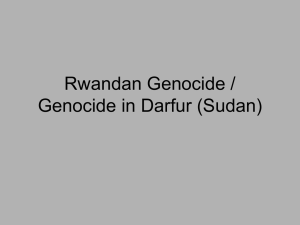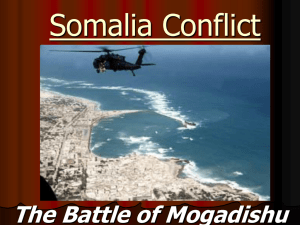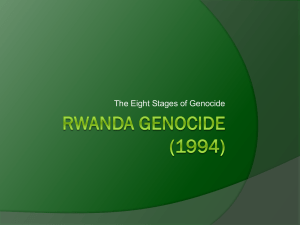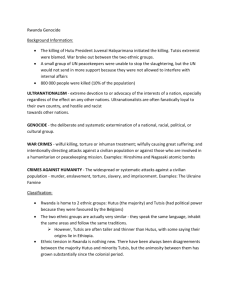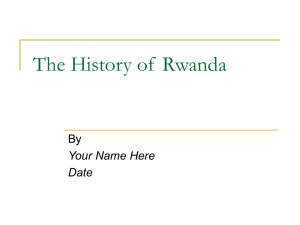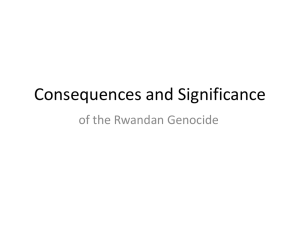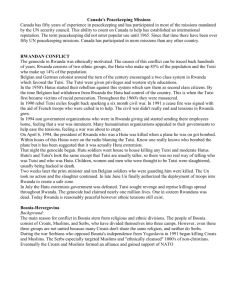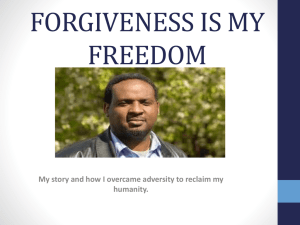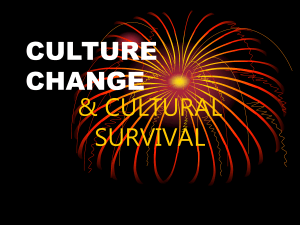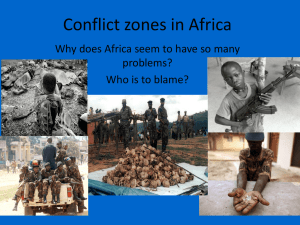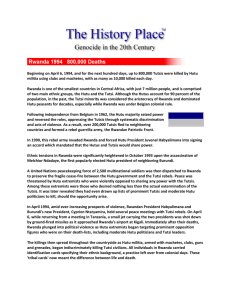Final Rwanda Power Point
advertisement
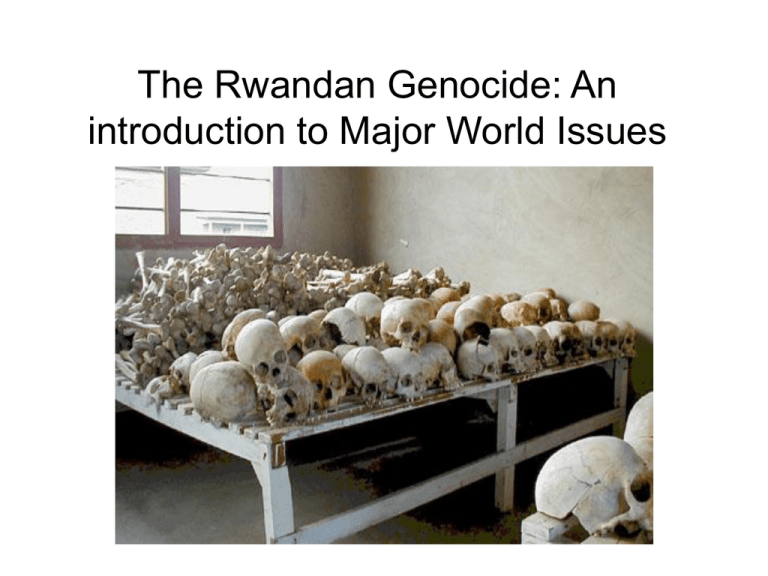
The Rwandan Genocide: An introduction to Major World Issues The Past According to the analysis of first All three classes paid tribute to the Tutsi colonizers to Rwanda and king in return for protection and various Burundi, (Germans first, and Belgians favours. Tutsi who lost their cattle later) the populations of Rwanda due to a disease epidemic and Burundi were divided into sometimes would be considered three ethnic-based classes: Hutus, Hutu; likewise Hutu who obtained Tutsis and Twas. cattle would come to be considered Tutsi, thus climbing the ladder of the social strata. (Today) The ethnic breakdown of the nation is roughly 84% Hutu, 15% Tutsi, and 1% Twa ( with smaller minorities of South Asians, Arabs, French, British, and Belgians). Hutus were considered socially inferior to Tutsis. Tensions Escalate After World War II Ruanda-Urundi became a United Nations (UN) "trust territory" administered by Belgium. In 1933 ethnic identification cards were used to classify one's ethnicity. Belgium and the Catholic Church’s “Contribution”s Catholic Church and the Belgians reinforced prejudices, inequality, and the idea of an “us” and “them”. Because of the existence of many wealthy Hutu who shared the financial (if not physical) stature of the Tutsi, the Belgians used a method of classification based on the number of cattle a person owned. (Anyone with ten or more cattle was considered a member of the aristocratic Tutsi class.) • From 1935 on, "Tutsi", "Hutu" and "Twa" were indicated on identity cards. • The Roman Catholic Church, the primary educators in the country, subscribed to and reinforced the differences between Hutu and Tutsi. They developed separate educational systems for each. • In the 1940s and 1950s the vast majority of students were Tutsi. The Beginning 1986 Paul Kagame, a Tutsi who had become head of military intelligence in the new Ugandan army, founded the RPF The Rwandan Patriotic Front They began to train their army to invade Rwanda from Uganda, and many Tutsis who had been in the Ugandan military now joined the RPF. In 1991, a radio station broadcasting RPF propaganda from Uganda was established by the RPF (So the Tutsis started the propaganda “battle”, but the Hutus took it much further) The government of Habyarimana responded in 1993 (to the RPF invasion) with a radio station that began anti-Tutsi propaganda On April 6, 1994, the Hutu president of Rwanda was assassinated when his jet was shot down, allegedly by missiles from the Ugandan army. Kagame and several members of Habyarimana's government, however, have claimed that disgruntled Hutus killed their own Hutu president, to justify the upcoming genocide. The Genocide In response to the April killing of the president, the Hutu-led military and Interahamwe militia groups killed about 800,000 Tutsis and Hutu moderates in the Rwandan genocide over the next three months (April - July 1994) UN member states refused to answer UNAMIR's requests for increased troops and money. Meanwhile, although French troops were dispatched, they were only able to evacuate foreign nationals and in some cases the genocide continued in zones they occupied while many highprofile Hutu war criminals escaped the RPF though French-controlled areas. All of these were common sites for an everyday Rwandan during this genocide. Burned and murdered, the dead were left to rot out in the open. Top right is a picture of a survivor who suffered numerous machete attacks. After the mass destruction of the Rwandan people, militia men and the military simply check to make sure no one is still alive and then leave the bodies to rot. All these people were most likely cut down with machine guns and machetes. War Rape Sexual violence against women and girls during the Rwanda genocide included: • rape • gang rape • sexual slavery (either collectively or individually through “forced marriages) • sexual mutilation Some women were kept as personal slaves for years after the genocide, forced to move to neighbouring countries after the genocide along with their captors. Pregnant women were not spared from sexual violence and on many occasion victims were killed following rape Over 20,000 children had been born as products of rape during the Rawandan genocide. HIV & War Rape Many women were raped by men who knew they were HIV positive and it has been suggested that there were deliberate attempts to transmit the virus to Tutsi women and their families. War rape occurred across the country and was frequently perpetrated in plain view of others, at sites such as schools, churches, roadblocks, government buildings or in the bush. Hotel Rwanda Post Civil War After the Tutsi RPF took control of the government, Kagame installed a Hutu president, Pasteur Bizimungu, in 1994. However when Bizimungu became critical of the Kagame government in 2000, he was removed as president and Kagame himself took over the presidency. Bizimungu immediately founded an opposition party (the PDR), but it was banned by the Kagame government. Bizimungu was arrested in 2002 for treason, sentenced to 15 years in prison, (but released by a presidential pardon in 2007). What Kagame did, and is doing, to Rwanda is stereotypical dictatorship behaviour. DICTATOR Present and Future Rwanda After the Tutsi-dominated RDF party took control of the government in 1994, they then wrote the history of the genocide and enshrined its version of events in the current constitution of 2003. They made it a crime to question the government's version of the genocide. In 2004, a ceremony was held in Kigali at the Gisozi Memorial to commemorate the tenth anniversary of the genocide, and the country observes a national day of mourning each year on April 7. Hutu Rwandan genocidal leaders are on trial at the International Criminal Tribunal for Rwanda, in the Rwandan National Court system, and, most recently, through the informal Gacaca village justice program. Recent reports highlight a number of reprisal killings of survivors for giving evidence at Gacaca. Continued... Some have made claims that the memorialisation of the genocide without admission of the crimes by the Tutsi-RDF are one sided, and is part of ongoing propaganda by the Tutsi-led Rwandan government (which is essentially a one-party government at this time). The author of Hotel Rwanda, Paul Rusesabagina, has demanded that Paul Kagame, the current Rwandan president, be tried as a war criminal. A constitutional amendment banned political parties from denoting themselves as being aligned with "Hutu" or "Tutsi." However, the RPF, a primarily Tutsi political organisation, was not disbanded and therefore continues its dominance. Rwanda today struggles to heal and rebuild, but shows signs of rapid development. One agent in Rwanda's rebuilding effort is the Benebikira Sisters. Since the genocide, the Sisters have housed and supported hundreds of orphans, and created and staffed schools to educate the next generation of Rwandans. In Eastern Rwanda, The Clinton Hunter Development Initiative are helping to improve agricultural productivity, improve water and sanitation and health services, and help cultivate international markets for agricultural products. The Rwandan government has announced that English will become the official language of the nation, replacing French. (This is partly an attempt to enable Rwanda to become a part of the global economic community, but is also a result of a long running feud between President Kagame and France over the apportioning of blame for the 1994 genocide). In 2008, Rwanda became the first country in history to elect a national legislature in which a majority of members were women
